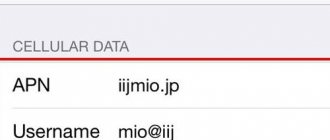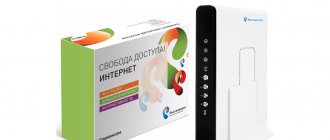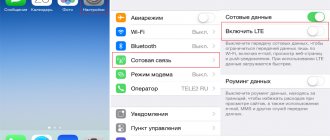Every Internet user has at least once wondered: where is all the information from the World Wide Web stored and how do we access it? Every day the worldwide network is expanding, new domains are appearing, and everyone, in order to avoid confusion, must have their own address (DNS server), assigned by large providers. The higher the server’s response speed, the higher the connection speed, while the user can set the server values, but Rostelecom’s DNS is assigned automatically, which makes the task easier.
What are DNS servers and why are they needed?
The abbreviation DNS stands for Domain Name System, through which the addresses of Internet resources are associated with digital IPs. They are necessary for organizing information on different DNS servers operating on the Internet, and are also used for quick searches. The global network is configured in such a way that each device has its own IP, through which “communication” occurs, sending requests between each other.
In order not to remember all IPs, a DNS domain name system was created. For example, the Rostelecom DNS server address stores data for a specific name in a digital interpretation. As a rule, this information is entered automatically at the time of connection. At the same time, the DNS registry contains data on the security policy, as well as lists of blocked sites (with viruses, pornography, prohibited information, etc.).
Thus, DNS performs the following functions:
- Acts as a guide to sites on the Internet.
- Filters unwanted and prohibited content.
- Sets basic parameters for ping, connection speed, etc.
Other reasons
In rare cases, breakdowns occur for the following reasons:
- Outdated network card software on your computer and laptop. Using Device Manager, check for the required drivers. If missing, install them;
- Antivirus blocks access to sites. Check your security software settings; it may be the reason why access to the World Wide Web is unavailable.
How to find out Rostelecom's preferred DNS servers
As noted, the Rostelecom server name is set automatically. Preferred addresses include the following:
- Priority - 48.193.36.
- Additional - 213.158.0.6, 212.48.193.36.
If you don’t touch anything, the Rostelecom DNS server settings are set without user participation.
If there is a problem, you can use other addresses (more on this below).
Conclusion
So, if failures occur when trying to open the site, server failures occur, or other errors appear, it is recommended to set up DNS addresses manually. The article provides detailed step-by-step instructions on how to use various methods when a particular problem occurs.
The DNS server is registered with Rostelecom automatically. Providers try to specify them so that the Internet speed is high and reliable. But sometimes the use of a DNS provider does not provide the required network speed. This article provides specific recommendations for solving a similar problem with Rostelekom servers.
Content
Alternative options
For many users, the main difficulty is finding an alternative Rostelecom DNS server. Typically, the following options are used:
- Yandex - 77.88.8.1 or 77.88.8.8;
- Google - 8.8.8.8 or 8.8.4.4.
As an alternative, you can select the fastest Rostelecom DNS servers using additional software. The best option is to use the DNS Benchmark program, which is available for free. It is used to search for the fastest DNS servers for the region of interest. Using the program, you can easily select a parameter and install it on your PC.
To choose which DNS server to register for Rostelecom, take several steps:
- Install DNS Benchmark software from the official website.
- Open the program distribution package.
- Look at Rostelecom's list of preferred DNS servers.
The advantage of the program is that it does not require installation. If you encounter any difficulties while performing the above steps, go to the Nameservers section and click on the Run button.
After some time, the necessary information will appear before your eyes.
Having at hand instructions on how to find out the preferred DNS server for Rostelecom, you will be able to quickly improve your network parameters. Additionally, using the program you can get tips on speeding up the Internet. To do this, go to the Conclusion section and read the tips.
Pay special attention to recommendations marked in red. It is important not to overdo it here, because the information is generated automatically and is not always correct.
Clearing cache
If the methods presented above did not help, then the problem lies deeper. In this case, when the DNS server does not respond, you can clear the network options cache. To do this you will need:
- Open command line. You can find it by pressing Win+R (enter cmd) or in the standard applications folder. Right-click on it and click on “Run as administrator”. The interface of operating systems is different, so the location of the command line in Windows 8 may differ.
- Enter the following queries one by one: ipconfig/flshdns, ipconfig/release, ipconfig/registerdns, ipconfig/renew. These commands clear the cache.
- Close a window. To restart a computer.
Common mistakes and their solutions
There are situations when you changed the Rostelecom DNS server address for your router, but you cannot connect. As a rule, problems arise due to the operation of an antivirus program or incorrect router configuration.
It is very important that the device settings indicate PPPoE connection and nothing else.
Another likely problem is difficulties with the network card.
If the IP address and name of the Rostelecom server are not recognized, restart the router. To do this, press the Power button to turn it off, and after a while turn the device on again.
If this doesn't help, take the following steps:
- Check that the entered data is correct. You may have made a mistake in one digit when specifying DNS.
- Update the drivers on the network adapter. To do this, check for updates using built-in features or additional software.
- Temporarily disable your antivirus program or firewall. If after this the virtual server on the router works, add the device to the list of exceptions.
- Try checking the box for automatic DNS connection or, conversely, set these parameters manually.
- Contact the technical support of your Rostelecom provider. Find out what may cause equipment malfunctions. As a rule, company representatives give good advice.
Address change procedure
What are the differences between 3G and 4G networks: features, advantages and disadvantages
So, if the DNS server network does not respond, the best option would be to change the address in the network settings on the computer. We will work with the Windows operating system. Our task is to find a working and nearby host, and if there is none, choose from Google or Yandex. The servers of these corporations are maximally tuned for fast and error-free operation.
Automatic selection is carried out by special applications. They easily find the DNS IP address of Rostelecom or another operator.
DNS Benchmark
One such tool is DNS Benchmark. First, check if Internet access is turned on, then scan and select the IP address offered by the program.
- It needs to be copied or written down somewhere.
- Next, change the system network settings parameters by opening the “Control Panel”. In Windows 10, enter this phrase in the search, and then study the result.
- Then open the “Network and Internet” section, then “Network and Sharing Center”, click on the “Change adapter settings” item on the left.
- In the window that opens, right-click on the wireless or wired connection used to communicate with the World Wide Web. Then go to "Properties".
- In the next step, find the line “IP version 4 (TCP/IPv4)”. Double-click on it with the mouse.
- A window with input fields will open. Below, select “Use the following DNS server addresses.” Enter the required value in both lines and click OK.
- If there are many computers connected to the network, connected, for example, via a local network, these parameters can be changed directly in the “Control Panel” of the Rostelecom router.
By choosing Google's DNS host as an alternative, the user will have constant and stable access to sites. The corporation's equipment is located all over the world and has backup equipment. The connection is made with a nearby host, respectively, if it is located far away, for example, somewhere in America, the answer from it will not “come” immediately. Therefore, the option of changing the address in the PC settings is optimal.
- How to connect Rostelecom Internet to a computer
Where it all began
The Internet network originated not so long ago, and its pioneers used only a few production computers to exchange data between them, so as not to run around the workshops and not look for the necessary document or technical specifications. To open the desired material on one of them, it was enough to enter its address, and all the data that was stored in the memory of another computer could be read or edited on another.
But, as you know, today the global computer network is only expanding, new domains and servers are being created, through which you can search for the desired material throughout the global Internet, and confusion can arise, since new addresses are registered on the network every day. And the main link in this is DNS servers, which can be provided by large Internet companies for ease of search and quick opening of a particular domain page. That is, a specific address where, in fact, information is stored for the time being, until someone needs to send a request from their computer to a specific IP address and open the necessary information on their computer.
The task of the DNS server is to convert a specific request into information understandable for computer machines, and to give permission to open it if it has already been created in a specific storage.
If it is not there, then it will contact the same servers of other systems, for example, Google or Yandex, where, in the end, the information the user needs will be found. That is, the user only needs to enter a query in the search bar, and the server will do the searching and opening itself.
The speed of the connection itself will depend on the response speed of the DNS server, so you need a preferred DNS that can quickly cope with its direct task - converting a request into opening an IP address.
Setting up a firewall
There is a possibility that access to the site was blocked by the native Windows Farewall or the firewall (another name for a firewall) that comes with your antivirus. The firewall blocks access to sites that it considers malicious. If you know that the blocked page is truly safe, you can temporarily disable the firewall or reset its settings to the initial settings (then the list of blocked pages will be reset to zero). How to turn off Microsoft's firewall? Click Control Panel->Windows and Security->Windows Firewall. In the left panel there will be an item “Turn Windows Firewall on or off.” Click it, then turn all the toggle switches to “Turn off Windows Firewall.” Save these settings.
Delegation of Responsibility
An important concept in DNS is delegation of responsibility. Information about computers included in a particular domain zone is stored on the DNS server, which is responsible for the operation of this zone. But we need to know which servers are responsible for which zone.
Nameserver records
For this, DNS records of the NS (Name Server) type are used. For example, the ns1.yandex.ru and ns2.yandex.ru servers are responsible for the yandex.ru domain zone, and as many as 3 servers are responsible for the urfu.ru domain zone. Records of the ns type are set on a higher-level domain, in our case on the server that is responsible for the ru zone. It is this server that contains ns records for the yandex.ru domain and for the urfu.ru domain.
But it is not enough for us to know only the domain names of DNS servers; we need to know their IP addresses. To do this, “sticky” A records are used, which indicate IP addresses. All other information about delegated domain zones is stored on these DNS servers.
Determining a name by IP address
In addition to determining the IP address of a computer by its domain name, the DNS system can be used for the inverse task of determining the domain name of a computer by its IP address. For this purpose, special zones are used, called reverse or reversible.
The reverse zone contains records of the PTR (Pointer) type, which match the computer's IP address to the domain name. However, due to technical limitations, DNS cannot work directly with IP addresses, so a workaround was invented for reverse zones by representing the IP address as a domain name. For these purposes, a special domain in-addr.arpa has been created and in this domain IP addresses are written in reverse order, for example the address 77.88.55.66 in the reverse zone will be written as follows 66.55.88.77.in-addr.arpa.
Provider
You can dereference sites through your provider, but this does not always work as expected. For an ordinary home user, everything can go unnoticed for the rest of your life, but if you work very closely with the Internet, trouble can come unexpectedly. My theses about provider servers:
- Stability leaves much to be desired - in the sense that once a year the stick shoots, and here once every couple of years their servers crash, sites do not open properly. An unpleasant moment, a home user might think that the Internet had fallen off, and the problem was buried on the surface. For some, falling once every couple of years is enough to make them happy.
- Territorial restrictions - some site will be banned from the DNS and the carcass will be lost. In fact, people rarely ban anything through it now, but, by the way, there were precedents for this.
- Slow zone updates (for me this is the most important point). Providers' servers update very slowly. The owner of the site changed his server (he wanted to move to more powerful hardware), changed his DNS settings to a new IP address, and such information can only reach a user in the region in a couple of days. And he will knock on a non-existent address, receive an inaccessible site, or a site with a violation of security certificates and a sea of other problems.
In summary, everything works, sometimes for a very long time and well, but there are disadvantages that can be easily replaced with alternative DNS.










